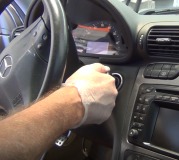Read this it may pertain to you, since the refineries are producing winter blend fuels still.
1989-99 F-150, F-250 LD, Ranger 1991-99 Explorer 1992-99 Econoline 1993-99 Villager 1995-99 Windstar 1997-99 Expedition, Mountaineer 1998-99 Navigator 1999 Super Duty F Series Medium/Heavy Truck: 1990-97 F-700 ISSUE Some vehicles using winter blend fuels may exhibit a stall on start up and a no restart, hard start condition or a no start condition in unseasonably hot weather (greater than 27 °C/80 °F). These concerns may be related to fuel volatility from winter blend fuels during winter-spring and autumn -winter transitions and may result in a fuel pump vapor lock condition. This condition may appear to be a fuel pump failure but may be caused by winter blend fuel. ACTION Refer to the following text for further information. NOTE: Fuel tank additives will not resolve these concerns because vapor forms from cavitation within the fuel pump. Filling the tank to full may be effective. Advise customer to use the recommended octane grade per owner manual and not a higher grade. Explain to the customer that this concern may be due to a low tank level of winter blend fuel combined with unseasonably warm weather. Advise customer that filling the fuel tank to full may be effective in resolving this concern. Also, advise customer to use the recommended octane grade per their Owner Manual and not a higher grade. BACKGROUND Gasolines are seasonally adjusted, meaning they have higher volatility (vaporize easier) in the winter and lower volatility in the summer. Government mandates to improve air quality have resulted in significant changes to gasolines, such as the mandatory use of oxygenates (ethanol, methyl tertiary butyl ether (MTBE), and others) in the winter or the reduction of Reid Vapor Pressure (RVP) in the summer. The addition of oxygenates (especially ethanol) increases volatility while the reduction of RVP reduces volatility. Gasoline distribution practices often do not allow branded marketers to have much control over their gasoline's volatility other than RVP. Oxygenate (e.G, ethanol, MTBE) use is more dependent on local gasoline markets, rather than specific marketers practice. Therefore, it is difficult to recommend specific brands to avoid volatility related complaints.
SPONSORED LINKS
Thursday, May 7th, 2009 AT 4:31 PM




